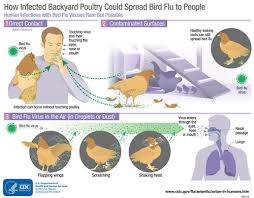A recent study conducted by the Centers for Disease Control and Prevention (CDC) has revealed that bird flu may be silently spreading among veterinarians without noticeable symptoms. The findings, published on Thursday, suggest that the official number of confirmed human cases could be significantly underestimated.
Undetected Infections Among Veterinarians
The CDC study echoes previous research that identified undiagnosed infections in farmworkers. Unlike those earlier studies, in which some farmworkers recalled experiencing symptoms, none of the veterinarians surveyed in the latest study reported symptoms associated with H5N1 bird flu, such as red eyes or respiratory issues.
To conduct the study, CDC researchers attended the American Association of Bovine Practitioners veterinary conference in September 2024 in Columbus, Ohio. They recruited 150 veterinarians from 46 states, who completed a questionnaire and provided blood samples. Tests revealed that three of them—about 2%—had antibodies indicating past H5N1 infections. All three veterinarians had worked with dairy cattle and other animals, though none reported direct contact with known infected herds. One had worked with a poultry flock confirmed to have been infected.
Evidence of Wider Exposure
Dr. Gregory Gray, an infectious disease researcher at the University of Texas Medical Branch in Galveston, emphasized that the study suggests more infections may be occurring without detection.
“This means that people are being infected, likely due to their occupational exposures, and not developing signs of illness and therefore not seeking medical care,” Gray said. He argued that relying solely on symptomatic cases reported at medical clinics underestimates the true scope of the virus’s spread.
Previous studies support these concerns. In one 2024 study of 14 dairy farmworkers, two (14%) showed evidence of past infections. Another CDC study of 115 dairy workers found that eight (7%) had antibodies indicating recent infection, with half of them recalling symptoms.
Gray noted that while the studies were small, even a low percentage of undiagnosed infections could mean that hundreds or thousands of people may have been unknowingly exposed to the virus.
Potential Risks and Precautions
While the findings indicate undetected transmission, experts stress that there is no immediate cause for alarm. Jacqueline Nolting, a researcher from Ohio State University who assisted with the CDC study, pointed out that people who contract H5N1 appear to develop an antibody response, potentially granting them some level of natural immunity.
However, the situation could change if the virus mutates to become more dangerous or more easily transmissible between humans. “If the virus changes or mutates to start making people very sick, or to start spreading easily from person to person, that would be a completely different story,” Nolting warned.
Continued Vigilance Advised
H5N1 bird flu continues to circulate among wild birds, poultry, dairy cows, and other animals, increasing the chances of human exposure. Though the CDC maintains that the risk to the general public remains low, officials encourage those in direct contact with infected animals to take precautions, such as wearing gloves, masks, and eye protection.
Dr. Keith Poulsen, director of the Wisconsin Veterinary Diagnostic Laboratory, said that veterinarians should expect increased guidance on protective measures. “No one’s really questioning that the virus has been moving around the country more than has been reported,” he said. “We need to make sure veterinarians and farmworkers protect themselves appropriately.”
Disclaimer
This article is based on current research findings and expert opinions. The understanding of bird flu transmission is evolving, and recommendations may change as new information becomes available. Readers are advised to stay informed through official health sources such as the CDC and the World Health Organization.
© 2025 The Associated Press.












